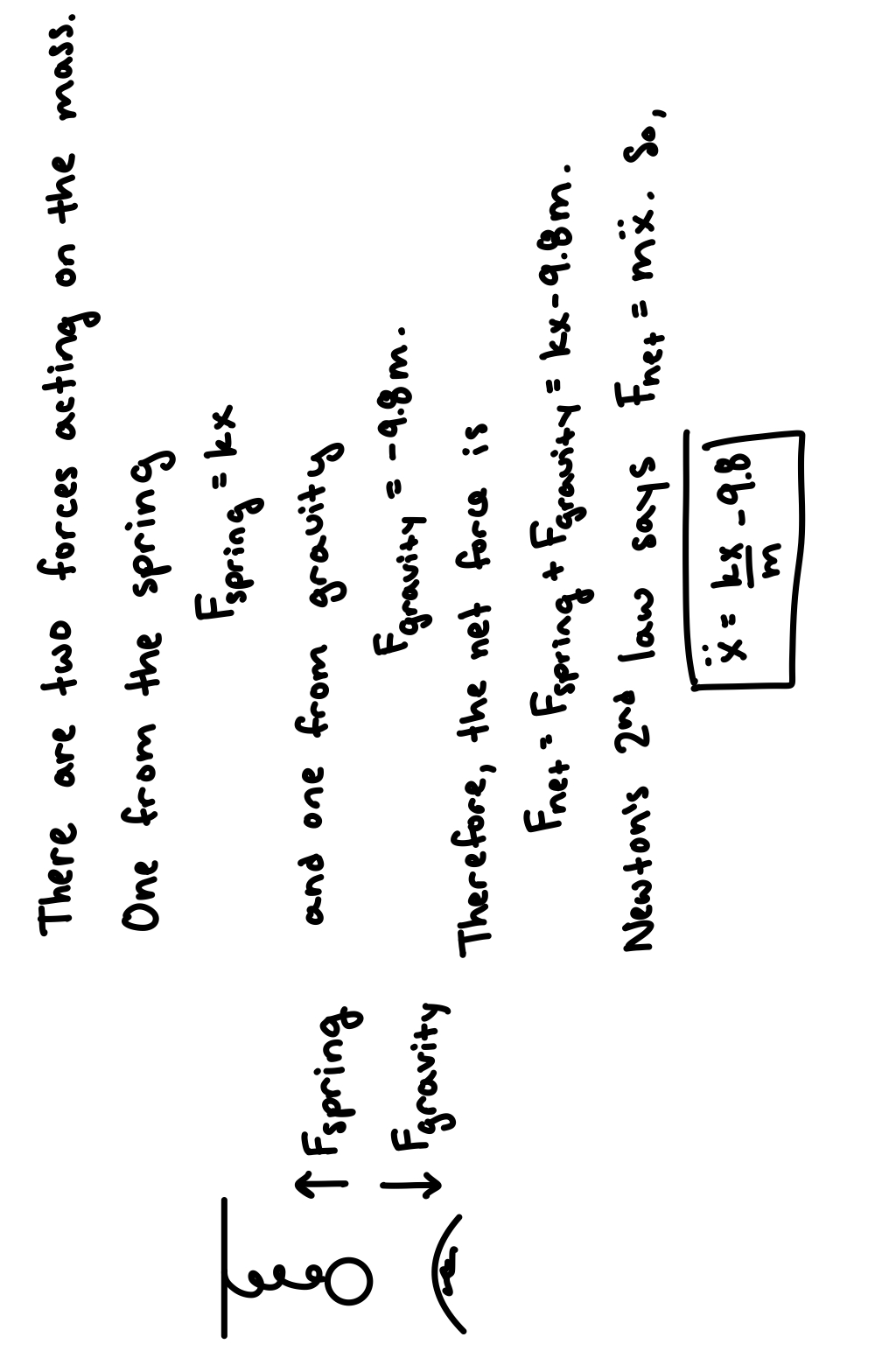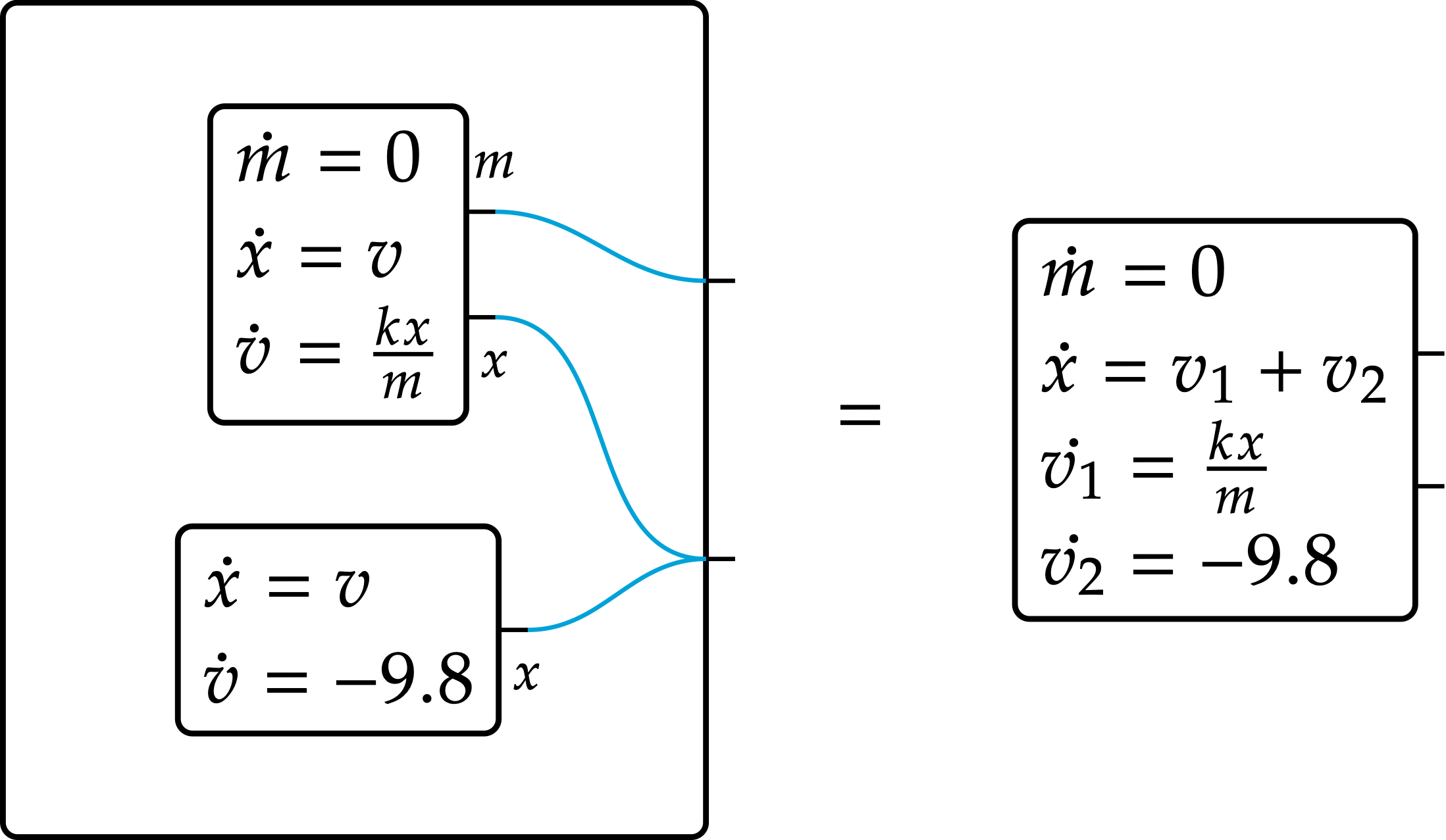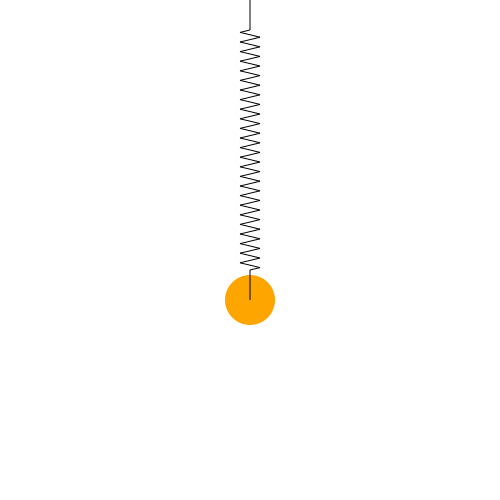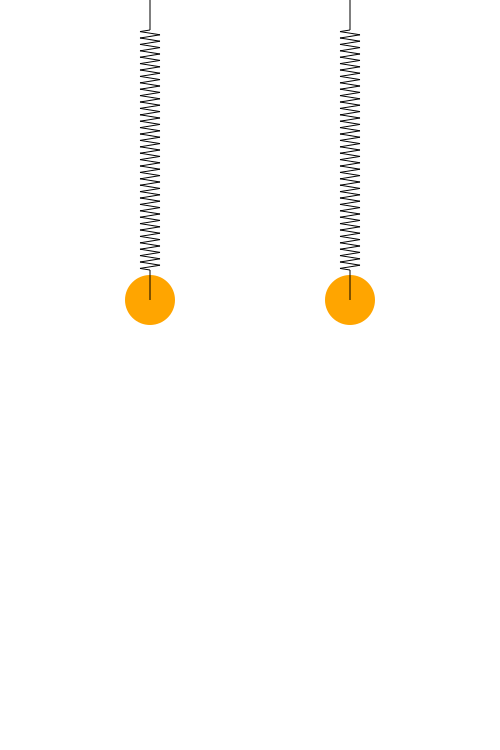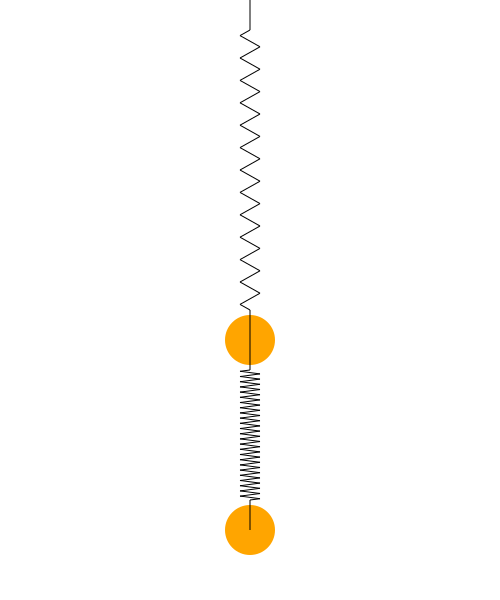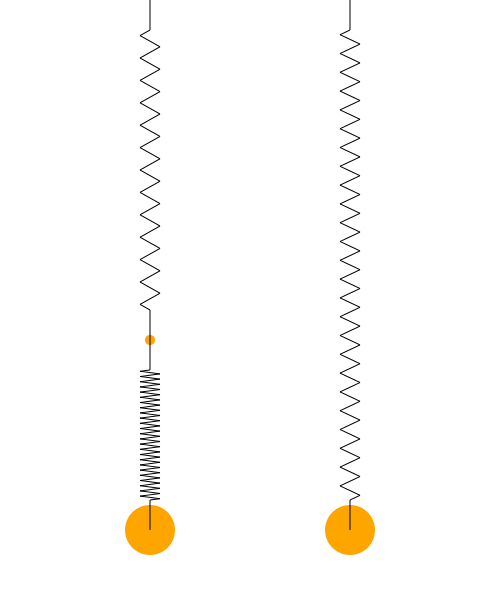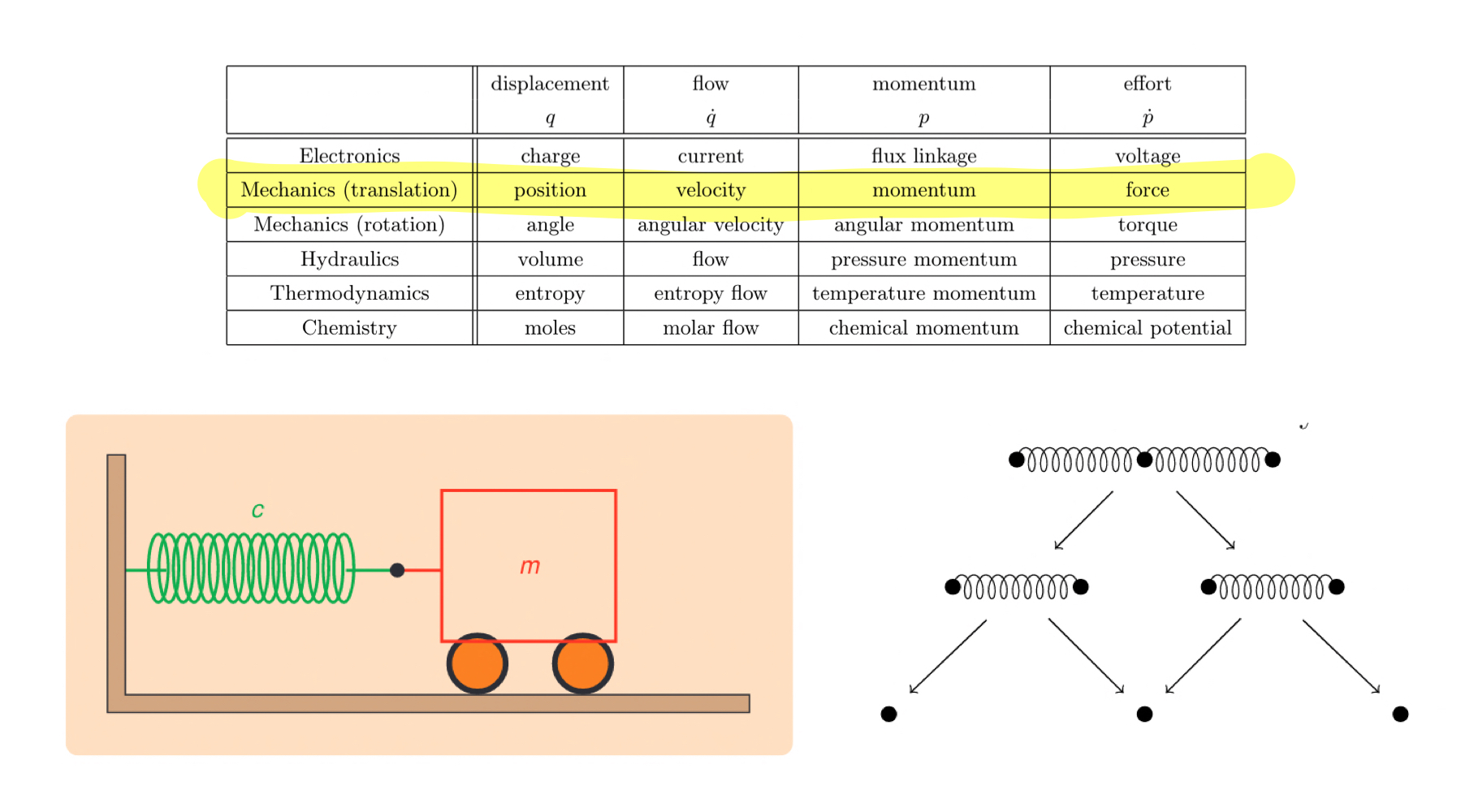Composing springs
Physical systems are often composed of many interacting subsystems. In this post, we take a peek at the math and the software implementation for composing systems of springs using decorated cospans.
1 Physics is hard
In my 16+ years of formal education, the lowest grade I’ve ever received was in General Physics I, which covered “vectors, kinematics, Newton’s laws and dynamics, conservation laws, work and energy, oscillatory motion,…”
There’s a textbook diagram that stands out in my memory as example of why this course was so challenging for me. The diagram contains a bunch of pulleys (where “a bunch” means like “3”) all connected to each other. One pulley made sense. Two pulleys, okay. But once there were many pulleys, many masses, and hence many forces to track, I would invariably lose my way. I understood each of the components, but in my physics education there was not a practice of explicitly representing their composition. Instead the composition pattern was implicit to the solving process, and so computing the composition of many pulleys was largely heuristic rather than a formal and legible process. Thankfully applied category theory is here to help me out.
Consider for example the problem of determining the oscillation of a spring on Earth. Here’s how undergraduate-me would have solved that problem:
That this system has two components (the spring and the effects of gravity) with a specified interaction (the mass in the two systems are the same) is hidden in the sum F_\text{total} = F_\text{spring} + F_\text{gravity}. Roughly,
We can formalize the interaction using an undirected wiring diagram (UWD) like this:
where m represents the mass and x represents the position of the mass. That the ports labeled x in each component system are wired together means that they are identified in the composite system.
We can formalize the component systems as differential equations using the operad algebra of resource sharers:
To solve this physics problem, I provide the components and interactions on the left-hand side, and the resource sharing machinery defines the composite system on the right. Then I can solve, \ddot x = \dot v_1 + \dot v_2 = \frac{kx}{m} - 9.8.
Using the same strategy of explicitly representing the components and their interactions, we can also understand two springs in parallel and in series:
2 Implementation in AlgebraicDynamics
In AlgebraicDynamics we can translate our whiteboard diagrams into compilable code in order to compute and then simulate the composite systems. Let’s do this for the spring on Earth.
First we implement the anchored spring as a ContinuousResourceSharer which specifies the interface and a particular choice of system with that interface.
function anchored_spring_dynamics(k)
(u,p,t) -> begin
mass, pos, vel = u
[0., vel, -k*pos/mass]
end
end
anchored_spring(k) = ContinuousResourceSharer{Float64}(
[:mass, :pos], # interface
3, # number of state variables
anchored_spring_dynamics(k), # dynamics
[1,2] # port map
)Let’s break down this specification:
[:mass, :pos]indicates that the interface of this system has two exposed ports labeled:massand:pos.3indicates that there are three state variables.anchored_spring_dynamics(k)returns a Julia function that defines the vector field for an anchored spring with spring constant k.[1,2]defines the port map, which indicates that the first port exposes the first state variable and the second port exposes the second state variable.
Given an initial mass, position, and velocity for the spring, we can use the DifferentialEquations Julia package to solve the system and plot the trajectories of the exposed state variables over time.
As expected the mass remains constant throughout the run while the position oscillates. While this plot is indicative, it is more fun to use Javis to animate our spring.
Now we’re ready for composition. While ContinuousResourceSharers represent single systems, UndirectedWiringDiagrams represent an interaction pattern. Once the primitives systems and the interaction patterns are defined, we can compose using the oapply method.
# Define the gravitational system
gravity_model = ContinuousResourceSharer{Float64}([:pos], 2, (u,p,t) -> [u[2], -9.8], 1:1)
# Define the interaction pattern as a UWD
interaction = @relation (mass, pos) begin
spring(mass, pos)
gravity(pos)
end
# Compose
spring_on_earth = oapply(interaction, Dict(:spring => spring, :gravity => gravity))Catlab automatically generates a visual of the UWD interaction.
The animation of a solution for the composite system spring_on_earth is exactly what we expect: the spring on Earth oscillates with the same frequency as the original spring but with a lower equilibrium point.
2.1 Springs in parallel
As shown in the introduction, we can construct springs in parallel as the composition of two anchored springs whose positions and masses are identified. This interaction pattern is encoded by the following UWD.
Now the implementation of springs in parallel is just a few lines of code.
k1 = 10.0; k2 = 20.0
spring1 = anchored_spring(k1)
spring2 = anchored_spring(k2)
interaction = @relation (mass, pos) begin
spring1(mass, pos)
spring2(mass, pos)
end
parallel_springs = oapply(interaction, Dict(:spring1 => spring1, :spring2 => spring2))A nice test of this example is to compare our springs in parallel to a single spring with spring constant {k_1 + k_2}. According to physics, these have the same behavior. And indeed that’s what we see.
2.2 Springs in series
For springs in series, we have an anchored spring connected to a free spring1 in which one anchor point of the free spring is the mass of the anchored spring. This interaction pattern is encoded by the following UWD.
Again, the implementation of springs in series is now just a few lines of code:
k1 = 10.0; k2 = 20.0
spring1 = anchored_spring(k1)
spring2 = free_spring(k2)
interaction = @relation (m1, m2, p1, p2) begin
anchored_spring(m1, p1)
free_spring(m1, p1, m2, p2)
end
series_springs = oapply(interaction, Dict(:anchored_spring => spring1, :free_spring => spring2))When both masses are 5 grams, we can simulate the springs in series and animate the results:
If the mediating mass is negligible, then our springs in series have the same behavior to a single spring with spring constant \frac{k_1 k_2}{k_1 + k_2}.
Pretty cool!
4 Resources
If you want to learn more about AlgebraicDynamics and the operad algebras it implements checkout the following resources:
- (watch) Happy Birthday AlgebraicDynamics.jl is a talk I gave at Topos’s Berkeley Seminar celebrating AlgebraicDynamics’s first birthday.
- (read) Operadic Modeling of Dynamical Systems: Mathematics and Computation gives a full account of several operad algebras for composing dynamical systems as well as their implementations in AlgebraicDynamics.
- (diy) Checkout AlgebraicDynamics on GitHub. In particular, this notebook reproduces the examples shared in this blog post.
References
Footnotes
The free spring has a mass, position, and velocity for both ends of the springs, so it has 6 state variables and 4 exposed ports.↩︎
Every decorated cospan category is a hypergraph category and every hypergraph category is 1-equivalent to a cospan algebra (Fong and Spivak 2019).↩︎
You can find more details about other of the algebras implemented in AlgebraicDynamics.jl in (Libkind et al. 2021).↩︎
